Acmadenia tetragona
Acmadenia tetragona (L.f.) Bartl. & H.L.Wendl.
Family: Rutaceae
Common names: pagoda flower, Outeniqua porcelain flower (Eng.)
Introduction
A hardy aromatic shrub that captures attention in spring, with its delicate, light pink flowers with pink nectar guides clearly visible in the centre of each petal.
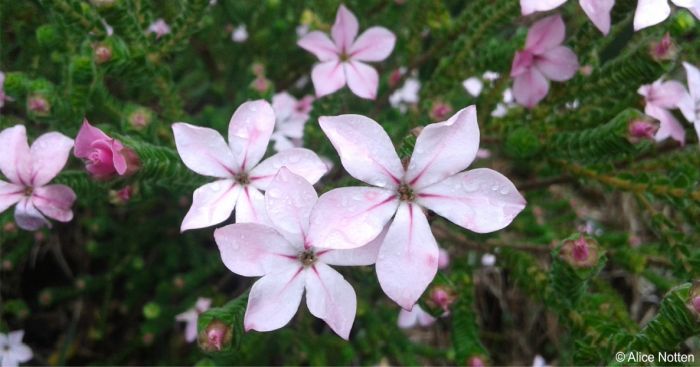
Description
Description
Acmadenia tetragona is a single-stemmed, much branched shrub that grows 300–600 mm high. The mature branches are dark brown, the new branches are light green to yellow, hairy, and closely leafy. The leaves are 4.8 mm long and 4.2 mm wide, almost circular (suborbicular) when pressed flat, folded upwards, strongly keeled, the margins fringed with long hairs (ciliate), with a very short petiole, arranged in opposite pairs with each pair at right angles to the other (decussate). Large, 20–25 mm diameter, 5-petalled, light pink flowers are borne singly, without a stalk (sessile), at the tips of the branches, from midwinter to early summer (July to November). The petals are egg-shaped (obovate) with a pointed tip, covered in small hairs with long hairs in the throat, and each petal has a darker pink nectar guide clearly visible in the centre. The petals form a closed throat below, concealing the stamens and style. The anthers have a large, pointed, apical gland less than 0.6 mm long. When the flowers dry up, they fall off the tips of the branches. Its fruits are 5-carpellate, with very short, 1 mm long, horns. As they mature, they turn brown and split open to release the 5 mm long seeds, which are shiny black when fully ripe.
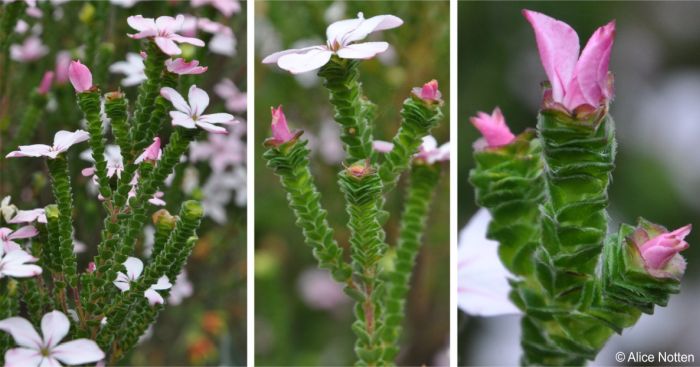
Conservation Status
Status
Acmadenia tetragona is assessed as Near Threatened (NT) on the Red List of South African Plants, it is locally common but restricted to a small range, with an extent of occurrence of just 408 km². It faces threats such as frequent fires, invasive alien plants, and habitat loss due to agriculture. It was assessed as Rare by Hilton Taylor in 1996 and Vulnerable (VU) by the Red List of South African Plants in 2009 and 2012, but surveys found it at 15–25 locations, indicating it is more widespread than previously thought and its threat status was revised to Near Threatened in 2013.
Distribution and habitat
Distribution description
Acmadenia tetragona is endemic to the Western Cape in South Africa. It is found in the Langeberg and Outeniqua Mountains, from Cloete’s Pass to Robinson Pass and in the Doringrivier Wildnerness Area. Plants occur on sandstone slopes in South Outeniqua Sandstone Fynbos, North Outeniqua Sandstone Fynbos, South Langeberg Sandstone Fynbos and Garden Route Shale Fynbos.
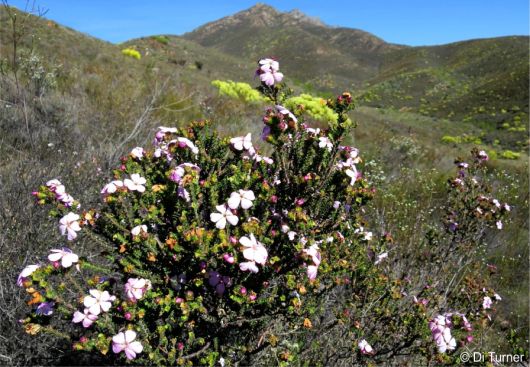
Derivation of name and historical aspects
History
The genus name Acmadenia is derived from the Greek words akme, meaning ‘highest point’, and aden, meaning ‘a gland’, which refer to the large conical gland on top of the anther, emphasizing the relevance of these glands in identifying the species of this genus. The genus consists of 33 species, that naturally occur in the Fynbos Biome. Acmadenia belongs to the citrus family (Rutaceae) and the leaves emit fragrance when rubbed as they have oil glands in the leaves.
The species name tetragona is also Latin and means ‘with four sides’, it describes the arrangement of the leaves where the closely set opposite pairs give the stems a 4-angled appearance. Its common name pagoda flower also refers to 4-angled pagoda-like stems. Acmadenias are also known as porcelain flowers.
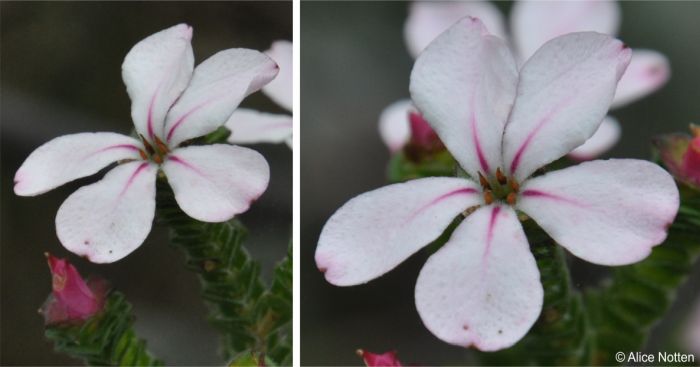
Ecology
Ecology
The flowers are pollinated by bees and other insects. The seeds have a black aril on one side, which attract certain ants that carry the seeds to their nests and consume the aril, leaving the rest of the seed unharmed either in the nest or on a midden. The seeds are thus dispersed and planted by the ants, a mutalistic association known as myrmecochory. The plants are killed by fire and the population regenerates from seeds stored in the soil.
Uses
Use
Acmadenia tetragona is very ornamental and can be used as garden plant, it is best suited to fynbos or Mediterranean-climate gardens with acidic soil.
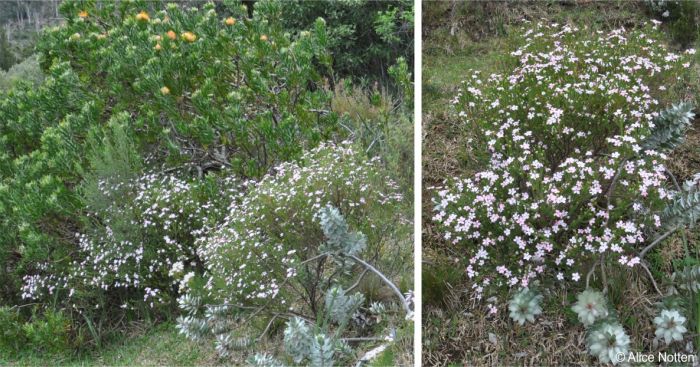
Growing Acmadenia tetragona
Grow
Acmadenia tetragona is not established in cultivation but has thrived in the motherstock beds at Kirstenbosch where it is planted on an east-facing slope in a sunny position with late afternoon shade and no irrigation. In the garden, it requires full sunlight, in an open, well-ventilated position with well-drained, acidic soil. It will benefit from being planted in well-prepared soil rich in compost and given a thick layer of mulch every year. Plants also respond favourably to slow-release fertilizer, such as 3:1:5. These plants are ideal for fynbos gardens, planted among other fynbos plants.
This plant is propagated vegetatively at Kirstenbosch NBG in the autumn, however attempts in other seasons are also possible. Take cuttings 25 to 55 mm long from the current year’s fresh growth. Remove around one-third of the foliage, cut below the node, and apply a rooting hormone. The rooting medium is a 50/50 mixture of fine-milled bark and perlite, but this might vary according on what is available. The cuttings are placed on a heated bench in a mist unit. Rooted cuttings are moved to a hardening section for roughly two weeks before being potted. Potted plants are placed in a shady region for up to two weeks to a month before they are moved to full sun area.
References
- Bond, W.J. & Slingsby, P. 1983. Seed dispersal by ants in shrublands of the Cape Province and its evolutionary implications. South African Journal of Science 79: 231-233.
- Jodamus, N. 2005. Acmadenia obtusata (Thunb.) Bartl. & H.L.Wendl. (Rutaceae). PlantZAfrica. Online. http://pza.sanbi.org/acmadenia-obtusata
- Leistner, O.A. (ed.). 2000. Seed plants of southern Africa: families and genera. Strelitzia 10. National Botanical Institute, Pretoria.
- Manning, J. & Goldblatt, P. 2012. Plants of the Greater Cape Floristic Region 1: the Core Cape Flora. Strelitzia 29. South African National Biodiversity Institute, Pretoria.
- Moeketsane, T. & Notten, A. 2023. Crassula tetragona L. (Crassulaceae). PlantZAfrica. Online. https://pza.sanbi.org/crassula-tetragona.
- Oliver, R. & Ndlovu, N. 2021. Acmadenia alternifolia Cham. (Rutaceae). PlantZAfrica. Online. https://pza.sanbi.org/acmadenia-alternifolia.
- Sonder, W. 1894. Acmadenia tetragona B. & W. (Rutaceae). Flora Capensis (1):381. Available at: https://www.biodiversitylibrary.org/item/15231#page/437/mode/1up.
- Turner, D. 2016-08. Observation of Acmadenia tetragona, Doringrivier Wilderness Area, WC. iNaturalist. Online. https://www.inaturalist.org/observations/11298174.
- Von Staden, L., Turner, D. & Hutchinson, S.L. 2013. Acmadenia tetragona (L.f.) Bartl. & H.L.Wendl. National Assessment: Red List of South African Plants. http://redlist.sanbi.org/species.php?species=3363-44.
- Williams, I.J.M. 1982. Studies in the genera of the Diosmeae (Rutaceae): 13. A revision of the genus Acmadenia Bartl. & Wen. Journal of South African Botany 48(1): 169–240.
Credits
Phophi Ceri Thovhakale and Alice Notten
Kirstenbosch National Botanical Garden
January 2025
Acknowledgements: the authors thank Di Turner for making her images of Acmadenia tetragona in habitat available via iNaturalist.
Plant Attributes:
Plant Type: Shrub
SA Distribution: Western Cape
Soil type: Sandy, Loam
Flowering season: Spring, Early Summer, Winter
PH: Acid
Flower colour: White, Pink
Aspect: Full Sun
Gardening skill: Average
Special Features:
Horticultural zones
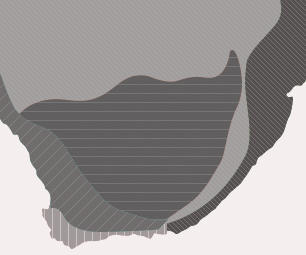







Rate this article
Article well written and informative
Rate this plant
Is this an interesting plant?
Login to add your Comment
Back to topNot registered yet? Click here to register.